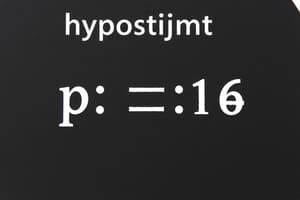Podcast
Questions and Answers
The process of using data drawn from samples to determine if a treatment had a statistically significant effect is known as ______.
The process of using data drawn from samples to determine if a treatment had a statistically significant effect is known as ______.
hypothesis testing
The ______ hypothesis (H0) states that a treatment has no effect.
The ______ hypothesis (H0) states that a treatment has no effect.
null
The ______ hypothesis (H1) claims that a treatment does have an effect.
The ______ hypothesis (H1) claims that a treatment does have an effect.
alternative
In hypothesis testing, if the computed ______ is more extreme than ±1.96, then the null hypothesis can be rejected.
In hypothesis testing, if the computed ______ is more extreme than ±1.96, then the null hypothesis can be rejected.
A common probability threshold for rejecting the null hypothesis is ______.05.
A common probability threshold for rejecting the null hypothesis is ______.05.
When calculating a Z-score, the distance between the sample mean (M) and the population mean (µ) is a critical ______.
When calculating a Z-score, the distance between the sample mean (M) and the population mean (µ) is a critical ______.
Hypotheses must be ______ exclusive, meaning one or the other must be true.
Hypotheses must be ______ exclusive, meaning one or the other must be true.
To make a decision in hypothesis testing, researchers must set ______ for rejecting the null hypothesis.
To make a decision in hypothesis testing, researchers must set ______ for rejecting the null hypothesis.
To calculate the Z-score, we use the formula Z = (______ - µ) / σ.
To calculate the Z-score, we use the formula Z = (______ - µ) / σ.
Type I errors occur when we _____ the null hypothesis when we should not.
Type I errors occur when we _____ the null hypothesis when we should not.
A Type II error happens when we _____ the null hypothesis when we should have rejected it.
A Type II error happens when we _____ the null hypothesis when we should have rejected it.
In a directional hypothesis, we can use a _____-tailed test.
In a directional hypothesis, we can use a _____-tailed test.
Type I errors are reduced by lowering the _____ level.
Type I errors are reduced by lowering the _____ level.
To reduce Type II errors, researchers should increase the _____ size.
To reduce Type II errors, researchers should increase the _____ size.
Bias in internal validity can occur if participants are not randomly _____ to treatment conditions.
Bias in internal validity can occur if participants are not randomly _____ to treatment conditions.
Statistical significance tests the presence of an effect, while _____ significance refers to the practical importance of the result.
Statistical significance tests the presence of an effect, while _____ significance refers to the practical importance of the result.
Flashcards
Null Hypothesis (H0)
Null Hypothesis (H0)
The hypothesis that there is no effect of a treatment.
Alternative Hypothesis (H1)
Alternative Hypothesis (H1)
The hypothesis that a treatment does have an effect.
Statistical Significance
Statistical Significance
A treatment's effect is likely not due to chance.
Critical Value (Z)
Critical Value (Z)
Signup and view all the flashcards
Significance Level (alpha)
Significance Level (alpha)
Signup and view all the flashcards
Rejecting H0
Rejecting H0
Signup and view all the flashcards
Z-Score
Z-Score
Signup and view all the flashcards
Sample Size (n)
Sample Size (n)
Signup and view all the flashcards
Type I error
Type I error
Signup and view all the flashcards
Type II error
Type II error
Signup and view all the flashcards
Non-directional Hypothesis
Non-directional Hypothesis
Signup and view all the flashcards
One-tailed Hypothesis
One-tailed Hypothesis
Signup and view all the flashcards
Internal Validity
Internal Validity
Signup and view all the flashcards
Random Assignment
Random Assignment
Signup and view all the flashcards
Z-score (in a Hypothesis Test)
Z-score (in a Hypothesis Test)
Signup and view all the flashcards
Study Notes
Hypothesis Testing Overview
- Hypothesis testing uses sample data and probability to determine if a treatment has a statistically significant effect.
- A meme states: "Your p must be > .05, because I fail to reject you." This highlights the importance of the p-value in hypothesis testing.
Stating Hypotheses
- Null Hypothesis (H0): Treatment has no effect.
- Alternative Hypothesis (H1): Treatment has an effect.
- Example: If testing a drug affecting IQ:
- H0: Treatment IQ = Untreated IQ (or Treatment IQ = 100)
- H1: Treatment IQ ≠ Untreated IQ (or Treatment IQ ≠ 100)
- Hypotheses are mutually exclusive (one or the other must be true) and exhaust all logical possibilities (no other options).
Setting Criteria
- Rejecting H0: This involves determining if the sample data is significantly different from the population to be unlikely due to chance. A common probability for rejecting the null is .05 (5%).
- Critical Values: Values of Z like +/-1.96 are cut-off points where if the calculated Z-score falls outside these bounds, then the null hypothesis is rejected.
- Example: If m = 106, μ = 100, and σ (standard deviation) = 15, a calculated Z-score of 2 would be considered significant (reject H0).
- The factors affecting the z-score are:
- Distance between sample mean (M) and population mean (μ).
- Sample size ( via Standard Error of the Mean (SEM)).
- σM =σ / √n (population standard deviation over the square root of sample size)
Common Errors
- Type I Errors (α): Rejecting the null hypothesis when it is actually true. (e.g., concluding a treatment has an effect when it doesn't). Lowering α (e.g., to .01) reduces the risk of a Type I error.
- Type II Errors (β): Accepting the null hypothesis when it's actually false. (e.g., concluding a treatment has no effect when it does). Reducing Type II errors usually requires a bigger sample or better measurements.
Random Selection and Assignment
- Non-random selection/assignment affects internal validity (how results are interpreted), not statistical conclusions.
Directionality
- Non-directional (2-tailed test): The effect could go in either direction (e.g., treatment could increase or decrease IQ).
- Directional (1-tailed test): The effect is expected to go in a specific direction (e.g., treatment is expected to increase IQ).
Effect Sizes
- Statistical Significance: The effect did not occur by chance but might be a very small difference if the sample size or SEM is large.
- Clinical Significance: The effect is meaningful in the real world, not just statistically significant.
- Cohen's d: A measure of effect size. The formula is: d = (M-μ) / σ . It is independent from sample size and statistical significance.
- Small effect ≈ 0.2 to 0.5
- Medium effect ≈ 0.5 to 0.8
- Large effect ≥ 0.8
Studying That Suits You
Use AI to generate personalized quizzes and flashcards to suit your learning preferences.



